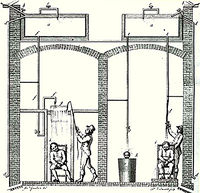Annotation:Mad Doctor (The): Difference between revisions
No edit summary |
m Text replacement - "garamond, serif" to "sans-serif" |
||
| (3 intermediate revisions by one other user not shown) | |||
| Line 1: | Line 1: | ||
'''Back to [[{{BASEPAGENAME}}]]''' | '''Back to [[{{BASEPAGENAME}}]]''' | ||
---- | ---- | ||
<p><font face=" | <p><font face="sans-serif" size="4"> | ||
'''MAD DOCTOR, THE.''' English, Country Dance Tune or Jig (6/8 time). A Major. Standard tuning (fiddle). AABB. A 'mad-doctor' was a physician who worked with the mentally ill, who were notoriously ill-cared for in such institutions such as Bedlam, where confinement was the only intervention. William Battie was a prestigious "mad-doctor" of the mid-eighteenth century who was instrumental in making the role of the mad-doctor respectable. He "rose to become President of the Royal College of Physicians" (Porter 1987, 167), and was one of the founders of St. Luke's Hospital. An admirer of Locke, Battie advocated a "reasoned therapeutic optimism" in place of the 'cures' of the day, which included blood-letting, purges, blistering and cold-water immersion. He stressed the need for strict, humane management and declaring that "the Regimen in this is perhaps more important than any distemper" (quoted in Porter 1987, p. 207) | '''MAD DOCTOR, THE.''' English, Country Dance Tune or Jig (6/8 time). A Major. Standard tuning (fiddle). AABB. A 'mad-doctor' was a physician who worked with the mentally ill, who were notoriously ill-cared for in such institutions such as Bedlam, where confinement was the only intervention. William Battie was a prestigious "mad-doctor" of the mid-eighteenth century who was instrumental in making the role of the mad-doctor respectable. He "rose to become President of the Royal College of Physicians" (Porter 1987, 167), and was one of the founders of St. Luke's Hospital. An admirer of Locke, Battie advocated a "reasoned therapeutic optimism" in place of the 'cures' of the day, which included blood-letting, purges, blistering and cold-water immersion. He stressed the need for strict, humane management and declaring that "the Regimen in this is perhaps more important than any distemper" (quoted in Porter 1987, p. 207) | ||
[[File:watertherapy.jpg|200px|thumb|left|Water Therapy devices, 18th century]] | |||
<br> | <br> | ||
<br> | <br> | ||
| Line 9: | Line 10: | ||
<br> | <br> | ||
</font></p> | </font></p> | ||
<p><font face=" | <p><font face="sans-serif" size="4"> | ||
''Source for notated version'': | ''Source for notated version'': | ||
<br> | <br> | ||
<br> | <br> | ||
</font></p> | </font></p> | ||
<p><font face=" | <p><font face="sans-serif" size="4"> | ||
''Printed sources'': Randall ('''Twenty Four Country Dances for the Year 1771'''), 1771; No. 14. | ''Printed sources'': Randall ('''Twenty Four Country Dances for the Year 1771'''), 1771; No. 14. | ||
<br> | <br> | ||
<br> | <br> | ||
</font></p> | </font></p> | ||
<p><font face=" | <p><font face="sans-serif" size="4"> | ||
''Recorded sources'': <font color=teal></font> | ''Recorded sources'': <font color=teal></font> | ||
</font></p> | </font></p> | ||
| Line 25: | Line 26: | ||
<br> | <br> | ||
---- | ---- | ||
'''Back to [[{{BASEPAGENAME}}]]''' | =='''Back to [[{{BASEPAGENAME}}]]'''== | ||
Latest revision as of 14:18, 6 May 2019
Back to Mad Doctor (The)
MAD DOCTOR, THE. English, Country Dance Tune or Jig (6/8 time). A Major. Standard tuning (fiddle). AABB. A 'mad-doctor' was a physician who worked with the mentally ill, who were notoriously ill-cared for in such institutions such as Bedlam, where confinement was the only intervention. William Battie was a prestigious "mad-doctor" of the mid-eighteenth century who was instrumental in making the role of the mad-doctor respectable. He "rose to become President of the Royal College of Physicians" (Porter 1987, 167), and was one of the founders of St. Luke's Hospital. An admirer of Locke, Battie advocated a "reasoned therapeutic optimism" in place of the 'cures' of the day, which included blood-letting, purges, blistering and cold-water immersion. He stressed the need for strict, humane management and declaring that "the Regimen in this is perhaps more important than any distemper" (quoted in Porter 1987, p. 207)

There is a "Medecin Extravagante (Le), or The Mad Doctor" in Thomas Hurst's Cotillons, Made Plain and Easy (London, 1775), but it is a different tune.
Source for notated version:
Printed sources: Randall (Twenty Four Country Dances for the Year 1771), 1771; No. 14.
Recorded sources:
